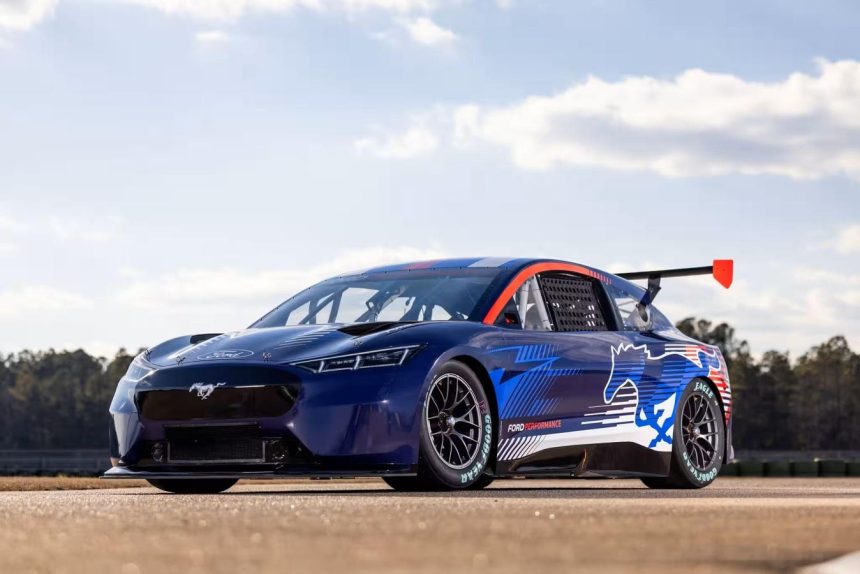Ford’s unveiling of an all-electric Mustang Mach-E, built to NASCAR specifications, ignites a debate about the future of motorsport. While NASCAR has been publicly exploring electric vehicle (EV) integration, their previous prototype, developed in collaboration with ABB, lacked the visual appeal and visceral excitement associated with traditional stock car racing. This bland, SUV-shaped prototype served as a functional demonstration of electric power but failed to capture the imagination of racing enthusiasts. Ford, however, has taken a decidedly different approach, presenting a Mach-E that closely resembles the current NASCAR Cup Series cars, sharing essential components like brakes, steering, suspension, and wheels. This aggressive move, coupled with the car’s sleek design and powerful 78-kWh battery pack, signals Ford’s intent to seriously explore the potential of electric racing.
Unlike the collaborative ABB prototype, which felt like a corporate compromise, Ford’s solo effort injects a sense of competition and innovation into the EV NASCAR narrative. Ford’s decision to independently develop and showcase its own EV racer suggests a proactive stance, potentially pushing other manufacturers like Chevrolet and Toyota to accelerate their own electric racing programs. This disruptive move, reminiscent of a classic “hold my beer” moment, transforms the conversation from theoretical discussions to a tangible demonstration of what an electric NASCAR future could look like. This bold approach, coupled with the announcement that the Mach-E will compete in the Pikes Peak International Hill Climb, elevates the vehicle from a mere showpiece to a serious contender in a challenging motorsport event.
The decision to enter the Pikes Peak race is a strategic move. It allows Ford to test the Mach-E’s performance in a demanding environment while generating publicity and gathering valuable data. This real-world test, far removed from the controlled environment of a test track, will provide crucial insights into the car’s capabilities and potential weaknesses. The data collected will be instrumental in further developing electric racing technology, potentially paving the way for future EV integration into NASCAR’s main series. The involvement of NASCAR champion Ryan Blaney further reinforces the seriousness of Ford’s commitment. Blaney’s presence at the launch event, along with his expressed enthusiasm about Ford’s EV endeavors, adds credibility and excitement to the project.
While Ford’s Mach-E offers a glimpse into a potential electric future for NASCAR, the sport’s overall transition to zero-emission racing faces significant challenges. NASCAR has pledged to achieve carbon neutrality by 2035, an ambitious goal that requires substantial technological advancements and infrastructure changes. The viability of this target depends on factors beyond NASCAR’s control, including the continued development of battery technology, the expansion of charging infrastructure, and the overall public acceptance of electric vehicles. The current political climate, marked by fluctuating support for EV initiatives, adds further uncertainty to NASCAR’s ambitious plan.
The potential shift to electric racing also raises fundamental questions about the very essence of NASCAR. The roar of V8 engines, a defining characteristic of the sport, would be replaced by the quieter hum of electric motors. This fundamental change could alienate traditional fans who are drawn to the visceral experience of internal combustion engine racing. The transition also presents technical challenges, including managing battery life and developing charging strategies that minimize disruption to race events. The success of electric NASCAR will depend on striking a balance between embracing new technology and preserving the core elements that define the sport’s identity.
The future of electric NASCAR remains uncertain, with technological, logistical, and cultural hurdles to overcome. Ford’s bold move with the Mach-E, however, serves as a catalyst, prompting crucial conversations and potentially accelerating the development of electric racing technology. Whether this future excites or concerns NASCAR fans, Ford’s initiative injects a new level of intrigue into the sport’s evolution. The Mach-E’s performance at Pikes Peak will be a crucial test, providing valuable data and potentially influencing the trajectory of NASCAR’s electric ambitions. The ultimate success of electric NASCAR hinges on navigating the complex interplay of technological advancements, fan acceptance, and the sport’s enduring commitment to exhilarating competition.



